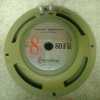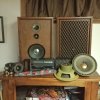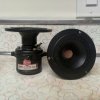The Stephens Trusonic Free Cone series was designed under Bert Berlant in 1958, and originally consisted of the 80FR, 120FR, and 150FR.
Twelve-odd years and two corporate owners later, my green-frame pair was apparently made in the Utah plant in Huntington, Indiana.

I never understood the prejudice against the green-frame (Utah) Trusonic speakers. Sure, Utah sent the Trusonic nameplate to hell with speakers indistinguishable from the main Utah line, but why hold that against perfectly respectable drivers like the 80FR?

Now, with a pair in my possession, I have an inkling as to why some people turn their noses up. The fit and finish (in earlier examples, on par with JBL or Altec) is just
shittier. The paint job on the frame isn't as good. The glue on the dustcap and voicecoil leads seems heavy-handed, and the surround treatment, absent in the original version, looks sloppy. Utah also dispensed with serial numbers and the Stephens name.

I've got a single earlier 80FR to compare this pair to, and I'm keen to see if the manufacturing differences will translate into measurably or audibly poorer performance.
I've got a pair of green-frame 150FR in the same cabs these 80FR came from. They have serial numbers, and were apparently made in California. I haven't pulled them yet, but it'll be interesting to see which way the build quality leans.









